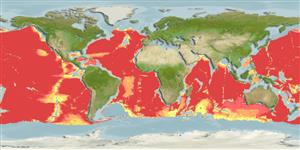>
Ophidiiformes (Cusk eels) >
Ophidiidae (Cusk-eels) > Neobythitinae
Etymology: Abyssobrotula: Greek, abyssos, deep, depth + Latin, brotula = little bud, shoot (Ref. 45335).
More on author: Nielsen.
Environment: milieu / climate zone / depth range / distribution range
Écologie
marin bathypélagique; profondeur 3110 - 7965 m (Ref. 130003). Deep-water; 60°N - 60°S, 180°E - 180°E
In deep waters of tropical and subtropical areas of all oceans. 3 specimens from the Gulf of Guinea (Ref. 3686).
Taille / Poids / Âge
Maturity: Lm ? range ? - ? cm
Max length : 16.5 cm SL mâle / non sexé; (Ref. 3686)
Description synthétique
Morphologie | Morphométrie
Head short with downward inflection. Snout swollen. Eyes small. Poorly developed opercular spine. Anterior gill arch with 8-11 developed gill rakers. Precaudal vertebrae 18-21.
The previous maximum depth reported was 8730 m, supposedy the deepest fish caught. However there was a mistake in the logbook of the station, the correct depht is now 7965 m, the third deepes fish 9as of Novemeber 2023 (Ref. 130003). Uncommon species (Ref. 34024). Reproductive strategy possibly similar to other members of this family being oviparous, with oval pelagic eggs floating in a gelatinous mass (Ref. 205).
Life cycle and mating behavior
Maturité | Reproduction | Frai | Œufs | Fécondité | Larves
Nielsen, J.G., 1990. Ophidiidae. p. 564-573. In J.C. Quero, J.C. Hureau, C. Karrer, A. Post and L. Saldanha (eds.) Check-list of the fishes of the eastern tropical Atlantic (CLOFETA). JNICT, Lisbon; SEI, Paris; and UNESCO, Paris. Vol. 2. (Ref. 3686)
Statut dans la liste rouge de l'IUCN (Ref. 130435)
Menace pour l'homme
Harmless
Utilisations par l'homme
Pêcheries: sans intérêt
Plus d'informations
Noms communsSynonymesMétabolismePrédateursÉcotoxicologieReproductionMaturitéFraiRassemblement de ponteFéconditéŒufsDéveloppement de l'œuf
Taille/ÂgeCroissanceLongueur-poidsLongueur-longueurFréquences de longueursMorphométrieMorphologieLarvesDynamique des populations larvairesRecrutementAbondanceBRUVS
RéférencesAquacultureProfil d'aquacultureSouchesGénétiqueElectrophoresesHéritabilitéPathologiesTraitementNutrientsMass conversion
CollaborateursImagesStamps, Coins Misc.SonsCiguateraVitesseType de nageSurface branchialeOtolithesCerveauxVision
Outils
Articles particuliers
Télécharger en XML
Sources Internet
Estimates based on models
Preferred temperature (Ref.
123201): 0.7 - 2.4, mean 1.4 °C (based on 34031 cells).
Phylogenetic diversity index (Ref.
82804): PD
50 = 1.0000 [Uniqueness, from 0.5 = low to 2.0 = high].
Bayesian length-weight: a=0.00380 (0.00165 - 0.00876), b=3.14 (2.93 - 3.35), in cm total length, based on LWR estimates for this (Sub)family-body shape (Ref.
93245).
Niveau trophique (Ref.
69278): 3.5 ±0.6 se; based on size and trophs of closest relatives
Résilience (Ref.
120179): Milieu, temps minimum de doublement de population : 1,4 à 4,4 années (Assuming tmax>3).
Fishing Vulnerability (Ref.
59153): Low vulnerability (10 of 100).
